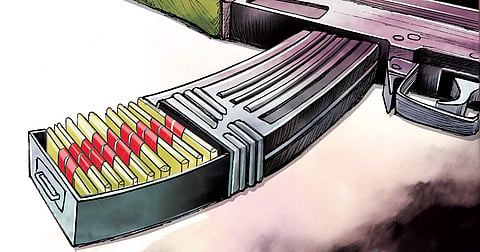

Defence Minister Nirmala Sitharaman said during a recent interview that India now has enough ammunition to fight an intense 10-day war. Just 10 days? Sitharaman is one of the Union Cabinet’s most hardworking and diligent ministers. But hard work and diligence may not be enough to deal with India’s chronically ill-managed Ministry of Defence (MoD).
The MoD had to make emergency off-the-shelf global purchases of ammunition to maintain high-intensity operations on the Line of Control (LoC) and international border (IB) as a contingency measure immediately following the surgical strike in Pakistan-occupied Kashmir (PoK) in September 2016. It is only after that, followed by a further increase in ammunition stock and new advanced weapons for the infantry, that the Indian armed forces can, according to the defence minister, fight an intense 10-day war on either the western or eastern front.
What if the war goes beyond 10 days? India’s MoD has had three ministers in the past four years: Arun Jaitley (twice), Manohar Parrikar and Nirmala Sitharaman. The rot in the MoD set in much before they arrived. The trauma of the Bofors scandal deprived India of new, advanced howitzers for 30 years. Between 2004 and 2014, Defence Minister A K Antony did little to streamline India’s weapons purchases. Submarine programmes like the Scorpene were caught up in scams while the number of fighter jet squadrons fell to 31 against the required strength of 42. The Narendra Modi government promised to reverse decades of drift.
On March 22, the MoD finally unveiled a draft of the Defence Production Policy 2018 (DProP 2018) which is ambitious in scope and intent. It mandates self-reliance by 2025 in fighter jets, tanks, missile systems, warships and autonomous weapon systems.
Sitharaman has tried to put weapons purchase systems back on track. But the absence of a senior military officer attached to the MoD remains a severe handicap. Bureaucrats in the defence ministry with shallow knowledge of military requirements often sit on files for months. They are one of the biggest obstacles in the path to modernise India’s forces.
Chief of Army Staff General Bipin Rawat has been expressing his dismay at the state of affairs. More formally, Army Vice Chief Lt. General Sarath Chand told the parliamentary standing committee on defence that the 2018-19 Union Budget’s allocation for the Army’s capital spending requirement on weaponry and force modernisation was inadequate.
Treating General Chand’s submissions with seriousness, the committee has prepared a draft report which says: “The Committee opines that keeping in view the likely cost escalation due to inflation, the increase over last year’s budget is quite minimal to meet requirements of capital acquisition and other works planned for 2018-19 ... The committee would like the Ministry of Defence to strongly put its case before the Ministry of Finance for adequate allocation of funds, commensurate with the requirement of modernisation and acquisition plans for 2018-19.”
Will things change? Unlikely. Such reports find an archival place in the black bureaucratic hole that the MoD is often likened to. The reference by the parliamentary committee to the ministry of finance (MoF) is particularly ominous. The bureaucracies in the MoD and MoF have deservedly acquired a reputation for being dismissive of budgetary requests by the armed forces. Unless the military has permanent representation in the MoD, this situation will not change. And change it must: Indian’s national security, especially at the LoC and IB, is at risk.
General Rawat has frequently spoken of the Indian armed forces’ readiness to fight a two-front war. But the reality is rather more grim. Soldiers complain of outdated assault weapons. Pakistan-sponsored terrorists killed in J&K are often armed with more sophisticated weaponry than the Indian soldiers’ weapons. Neglect extends to inadequate rations, poor living conditions in some Army camps and lax perimeter security. The terrain along the LoC is difficult to protect. But lack of modern firepower can affect troop morale.
In contrast, Chinese troops across the Line of Actual Control (LAC) and Pakistan’s Army regulars carry advanced weaponry. Chinese president Xi Jinping’s declaration of being prepared to wage a “bloody battle” may be rhetorical bluster but underscores the challenge India faces.
Sitharaman remains confident of a turnaround in the armed forces’ bid to modernise itself to fight more than just a 10-day war. Her target is to build up ammunition stocks for an intense 40-day war—a target that should have met a decade ago. Apart from involving the Indian private sector in defence manufacturing, Sitharaman is pushing government-owned defence organisations to speed up delivery schedules. Both Bharat Dynamics and Hindustan Aeronautics went public in March 2018. As listed companies, HAL and Bharat Dynamics will come under greater public scrutiny.
The key problem with India’s armed forces is civilian neglect over decades. In China, military officers are closely involved at every stage of weapons acquisition and modernisation. In Pakistan of course the Army sets its own inflated defence budget. Civilians play no role. India goes to the other extreme. The majority of the annual defence budget is swallowed up by salaries and pensions. At less than two per cent of GDP, there is just not enough money left in the defence budget to modernise the Army, Navy and Air Force. Bureaucratic shenanigans in the MoD compound the problem.
Sitharaman needs to tackle both problems—budgetary and bureaucratic—if India is to be fully prepared for more than just a 10-day war.
Minhaz Merchant Q
The author is an editor and publisher
Tweets @MinhazMerchant